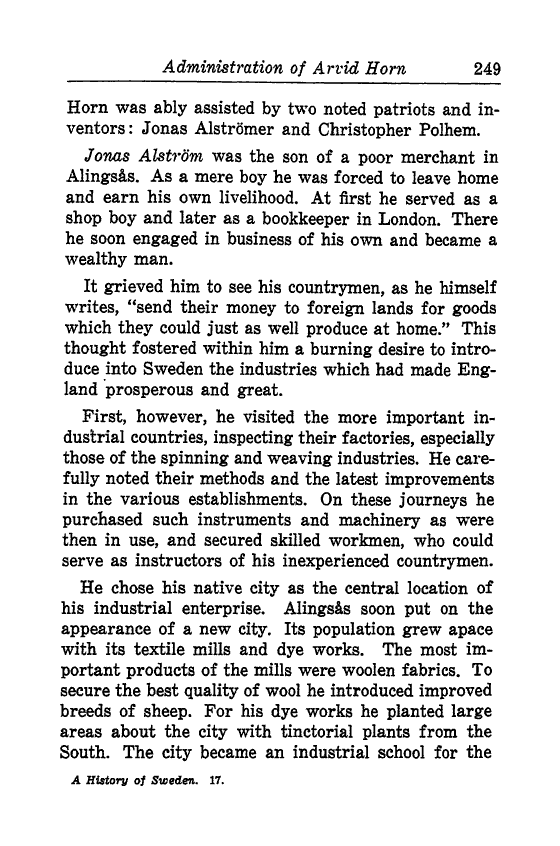
Full resolution (TIFF) - On this page / på denna sida - XIV. Reign of Ulrica Eleonora and Frederick I, 1719–1751 - D. Administration of Arvid Horn

<< prev. page << föreg. sida << >> nästa sida >> next page >>
Below is the raw OCR text
from the above scanned image.
Do you see an error? Proofread the page now!
Här nedan syns maskintolkade texten från faksimilbilden ovan.
Ser du något fel? Korrekturläs sidan nu!
This page has never been proofread. / Denna sida har aldrig korrekturlästs.
Administration of Arvid Horn 249
Horn was ably assisted by two noted patriots and in-
ventors : Jonas Alstromer and Christopher Polhem.
Jonas Alstrom was the son of a poor merchant in
Alings&s. As a mere boy he was forced to leave home
and earn his own livelihood. At first he served as a
shop boy and later as a bookkeeper in London. There
he soon engaged in business of his own and became a
wealthy man.
It grieved him to see his countrymen, as he himself
writes, "send their money to foreign lands for goods
which they could just as well produce at home." This
thought fostered within him a burning desire to intro-
duce into Sweden the industries which had made Eng-
land prosperous and great.
First, however, he visited the more important in-
dustrial countries, inspecting their factories, especially
those of the spinning and weaving industries. He care-
fully noted their methods and the latest improvements
in the various establishments. On these journeys he
purchased such instruments and machinery as were
then in use, and secured skilled workmen, who could
serve as instructors of his inexperienced countrymen.
He chose his native city as the central location of
his industrial enterprise. Alingss soon put on the
appearance of a new city. Its population grew apace
with its textile mills and dye works. The most im-
portant products of the mills were woolen fabrics. To
secure the best quality of wool he introduced improved
breeds of sheep. For his dye works he planted large
areas about the city with tinctorial plants from the
South. The city became an industrial school for the
A History of Sweden. 17.
<< prev. page << föreg. sida << >> nästa sida >> next page >>